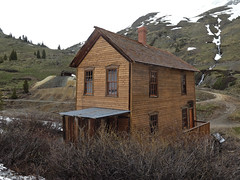Photography Now & Then #64
Karen’s heirloom quality oak quilting frame was given an upgrade a few weeks back. For a lot of years, she had been using clamp-on lights on the bar over the frame. I had hoped that the new track lighting in the room would alleviate the need. However, the bar across the top of the frame would cast a shadow across part of the area where Karen would be quilting, so additional lighting was needed to compensate for the shadow and the clamp lights went back on.

Now: Lighted quilting frame loaded with quilt top, batting and backing; March 5, 2018 (Apple iPhone 6s)
The solution was an 8 foot length of LED strip lighting. It was adhesive backed, but, when I first put it on, it was considerably off center, so I had to move it. As a result, the adhesive backing wasn’t enough to keep it from coming loose. However, when I bought the lighting, I had also purchased a roll of double-sided adhesive tape, so was able to affix the light more permanently.
______________________________________
We’ve made Several trips, over the years, up the Animas River to the old mining ghost town of Animas Forks. Situated at 11,200 feet in elevation in Colorado’s San Juan Mountains, the harsh environment, avalanches, fires in 1891 and 1931, vandalism, and time have taken a toll on the town buildings – few remain.

Then: Duncan House, built by William H. Duncan, a miner and mail-carrier, circa. 1879; Animas Forks, Colorado, remnants of a former mining camp; photo September 8, 2009 (Pentax K10D)
Duncan House1, 2
In 1879 Pennsylvanian William Duncan, a miner and snowshoe mail-carrier, built a two-story wood-frame house in Animas Forks, just five years after the townsite was established. Its beautiful bay windows look across to the river and the Columbus Mine which sits in the fork of the Animas River.
 The Duncan family, with two daughters and a son, was one of the initial four families in the late 1870s to brave the high altitude Animas Forks conditions year round. The family departed the town in 1884.
The Duncan family, with two daughters and a son, was one of the initial four families in the late 1870s to brave the high altitude Animas Forks conditions year round. The family departed the town in 1884.
In 2013–14, the Duncan House received a comprehensive restoration as part of a site-wide stabilization project overseen by the Mountain Studies Institute.
- Various websites and BLM signage
 Photo of the restored Duncan House by Zruda is licensed under Creative Commons Attribution-NonCommercial-ShareAlike 2.0 Generic (CC BY-NC-SA 2.0) license.
Photo of the restored Duncan House by Zruda is licensed under Creative Commons Attribution-NonCommercial-ShareAlike 2.0 Generic (CC BY-NC-SA 2.0) license.
Photography Now & Then Notes:
- Series Photos
- The Now photo is a one that is almost always taken the day of the blog post. In some instances, posts may be backdated if internet access is not available on the day of the photo or other reasons prevent posting Photography Now and Then.
- The Then photo is a randomly selected older photograph from a batch of photos specifically “curated” for Photography Now and Then.Each photo in this series is an “original work” – a copyright term – of Michael Goad.
- Reference links were accessed on the date the blog post was published, unless otherwise stated.
- The title convention for Photography Now & Then blog posts evolved early on from one word related to each photo separated by “&” to usually being the first word in the caption description for each photo.

